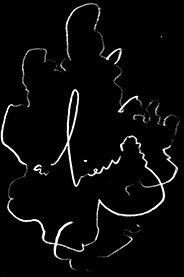Breath Work:
Abbra Kotlarczyk
Gently inhale & exhale
Right lung, left lung, blink [1]
Hold on to your seat real tight, hold your breath, keep your eyes in your head, and go on [2]
Meditate on the colour that is flesh void of oxygen, also the
discoloured fruit / fingered out of misted windows / into which I breathed [3]
for years i stood / in the semeny ginko staring at my hands believing / in afterlives thinking one day I’d wake into / a new kind of body like a fish suddenly / breathing air through its eyes [4]
When ready, place your right pointer finger in the centre of your forehead, your thumb over your right nostril, your middle finger searching for its erogenous zone.
o separate(d)/strands of our breath!/Bright silver/threads of spirit/O quicksilver/spurt of fist, scansion of/unfocused eyeball [5]
While here, practice pushing air from the back of your throat up into your eye sockets.
consider making this your mourning practice.
you don't refuse to breathe do you [6]
the primary medium of poetry is not language but breath, specifically the breath of the poet marrying the breath of the reader. This is the key to its intimacy, its strange physicality [7]
the HEAD, by way of the EAR, to the SYLLABLE / the HEART, by way of the BREATH, to the LINE [8]
This is (also) why bad poetry hurts so much [9]
becoming dragonfish to survive / the horrors we are living / with tortured lungs / adapting to breathe blood [10]
the hellish (but breathable) finitudes of our present conjuncture [11]
Inhale & raise your arms / above your head (...)
Apply a small amount of tea tree oil to the tip of a cotton ball (...)
all arrangements require pain (...)
Hold the cotton ball up to the opening of your mouth, so that your breath might catch its oil and become dry, brittle, might shrink
Is not the acquisition of speech based on the ability to fit the words in one’s mouth? To push the lips this way and that, shaping breath into particular forms? [12]
Slowly, peel your breathing away from its body so that it becomes a tender outlier draped on the floor. Look over at your sculpted breath-skin; attend to it daily. Think about what it means to denature, to render something so alive—antibacterial, antifungal. Are you now: analgesic; anti - viral?
as you slowly lower your arms, exhale / & pour your pleasure into a crystal vase [13]
Hold it there, applying a veil of empathic gauze over the mouth of the vessel so that your pleasure can still receive air, but not without effort.
Repeat three times:
As long as the earth continues / its stony breathing, I will breathe. [14]
Smother all illusions, alas
stones only breathe once a year. [15]
Like last night, on the riverbank, between the moss and the / baby’s-breath, where he had kissed her sticky until she cried out from / her chest [16]
Combat breathing names the mobilisation of the target subject’s life energies merely in order to continue to live, to breathe and to survive the exercise of state violence [17]
If we can inhale/exhale with perfect / regularity, [18]
if breath / is a leash to hold the mind [19]
proceed to attune to all the ways in which your body—
A body can cause almost anything / to happen. [20]
In the moments before sleep, close your eyes and hold your breath; repeat the words “I can’t breathe” eleven times. Think about what it means to hold.
the new shoots / the streaking old gums / to dawn to dew to breath / held [21]
you don't refuse to breathe do you [22]
the immediacy of the experience of breathlessness creates an epistemic mismatch between the person suffering and the person observing [23]
His breath a misplaced weather [24]
Was he limp? Did he stir/ w/ life? Did she hear/ his soft breath in her ear? [25]
Snow kites stretch prone in corries, altitude / stiffens breath. [26]
Where the Greek root of algorithm—algos—means pain, scroll hungrily through your social media feed, breaking the images open through attention to your bio-rhythmic selves.
Do this by focusing on any of a combination of the qualities of the breath that abound:
metonymic ; sentient ; terrestrial ; biotic ; combatant ; pneumatic ; rapid ; languid ; diaphragmatic ;
throbbing ; tranquil ; calm ; strained ; delicate ; laboured ; stale ; sticky ; wet ; drunk ; panicky ; peaceful ;
egalitarian ; sweet ; abundant ; precarious ; necessary.
there is a space between the layers, a palimpsestic interval one is always trying to inhabit, a lateral fascination through which attention passes, as the appositional sending of (an) air, an exploratory envoy of breathing [27]
Is this attention more or less surplus?
a “superfluous” mention of breath (that) must therefore designate an emphasis [28]
?
The breathing catastrophe [29]
—
